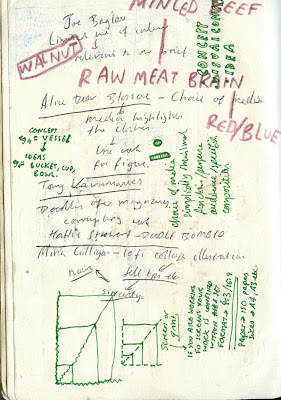Final Outcome
I have tried to create layered imagery that illustrates a chaotic mind overrun with thoughts and the constant connection between humans and the digital world. I feel like this style of working is much better at communicating the negatives related to the digital age. My favourite of the three is the landscape illustration, which shows a group of people being notified of things they need to do, I have tried to show this through visual references to the notification signs used in mobile phones and social networking. The faces are featureless/expressionless because the onslaught of technology and it's power has sucked them of their ability to enjoy things properly, like going for a meal with friends as stated in the article.
There is evidence of layers of work which are also part of the developmental process in creating these illustrations. I found that I was able to combine black and yellow to create an extra colour to work with. Smearing paint and contrasting it with block areas of black breaks up the images and highlights areas of text I want the audience to focus on. Looking back at my work I am unsure about the hashtag reference to twitter in the portrait format, I think the way I have a written it is incongruous with the rest of imagery and almost looks like an afterthought. Small detailing has played a part in creating 'busy' pictures, for example I made use of charcoal, byro pens and stitching thread to show distress and complexity.
If I were to do this brief again I would research further into the anatomy of the brain, which I think would give me a lot of inspiration and ideas to work from. I think it would be good to try and respond to the article from a narrative point of view, I feel as though my work doesn't really connect on a personal level and is sometimes a bit 'cold' in the delivery of its message.
I have learnt a lot about the importance of format and composition on this brief, which directly affects the dynamism of the image and how successfully it communicates. Limited colour has been interesting to work with but is a limitation I would rather not work against in the future, I kept finding myself wanting to add something more and feel as though the work is missing something. In future I will constantly be thinking about these important elements that make up a picture even from the very initial idea sheets.
Group Crit
Self Evaluation


























.jpg)























